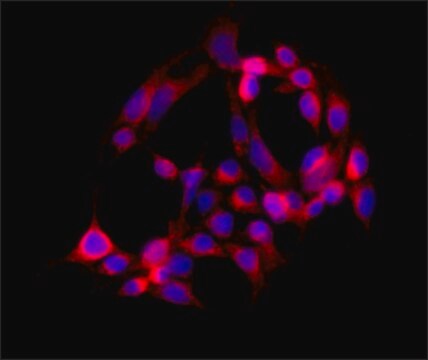MABS1988
Anti-SREBP-2 Antibody, clone 22D5
clone 22D5, from rabbit
Sinonimo/i:
Sterol regulatory element-binding protein 2, SREBP2, Sterol regulatory element-binding transcription factor 2
About This Item
Prodotti consigliati
Origine biologica
rabbit
Livello qualitativo
Forma dell’anticorpo
unpurified
Tipo di anticorpo
primary antibodies
Clone
22D5, monoclonal
Reattività contro le specie
mouse, human
tecniche
western blot: suitable
Isotipo
IgG
N° accesso NCBI
N° accesso UniProt
Condizioni di spedizione
ambient
modifica post-traduzionali bersaglio
unmodified
Informazioni sul gene
human ... SREBF2(6721)
mouse ... Srebf2(20788)
Descrizione generale
Specificità
Immunogeno
Applicazioni
Signaling
Western Blotting Analysis: A representative lot detected SREBP-2 in Western Blotting applications (McFarlane, M.R., et. al. (2015). J Lipid Res. 56(8):1560-71).
Qualità
Western Blotting Analysis: A 1:1,000 dilution of this antibody detected SREBP-2 in 10 µg of HepG2 cell lysate.
Descrizione del bersaglio
Stato fisico
Stoccaggio e stabilità
Handling Recommendations: Upon receipt and prior to removing the cap, centrifuge the vial and gently mix the solution. Aliquot into microcentrifuge tubes and store at -20°C. Avoid repeated freeze/thaw cycles, which may damage IgG and affect product performance.
Altre note
Esclusione di responsabilità
Non trovi il prodotto giusto?
Prova il nostro Motore di ricerca dei prodotti.
Codice della classe di stoccaggio
10 - Combustible liquids
Classe di pericolosità dell'acqua (WGK)
WGK 2
Certificati d'analisi (COA)
Cerca il Certificati d'analisi (COA) digitando il numero di lotto/batch corrispondente. I numeri di lotto o di batch sono stampati sull'etichetta dei prodotti dopo la parola ‘Lotto’ o ‘Batch’.
Possiedi già questo prodotto?
I documenti relativi ai prodotti acquistati recentemente sono disponibili nell’Archivio dei documenti.
Il team dei nostri ricercatori vanta grande esperienza in tutte le aree della ricerca quali Life Science, scienza dei materiali, sintesi chimica, cromatografia, discipline analitiche, ecc..
Contatta l'Assistenza Tecnica.








